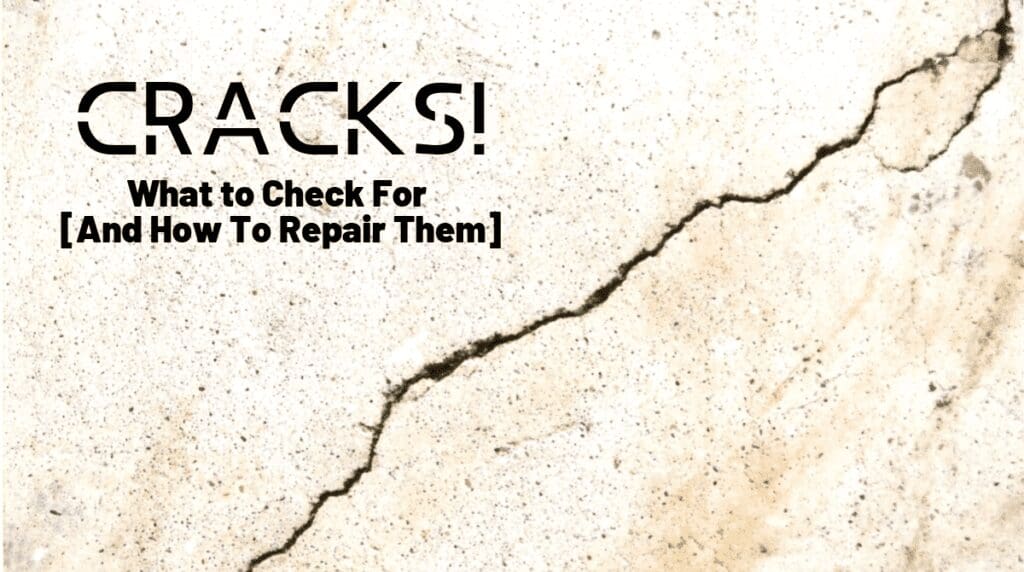Cracks are an alarming thing to find in a home! Whether it is something you find in a new home or an old home, it can be an uncomfortable experience to notice cracks forming in the walls. While they can sometimes be a sign of a bigger issue, oftentimes, cracks are just symptoms of the wall settling over time. In order to determine what needs to be addressed with the foundation and what can be fixed cosmetically, Allied has created this guide on cracks – what to check for and how to fix them.
When A Crack Is Foundational
Foundation problems are an unfortunately common piece of owning a house. While it may seem scary to have these kinds of cracks in the home, it is better to acknowledge them as soon as possible! Cracks will be different depending on the material the wall is made of. For plaster and drywall, it is important to look for cracks that are diagonal, or “stair-step”. These are usually telltale signs of a foundation issue. These are important to take note of and track over time if they are relatively thin. If they are bigger than 1/4 of an inch, they need to be addressed.
For concrete walls, it is a little bit different. In concrete walls, almost every single kind of crack is dangerous or an indication of foundation issues. Vertical and diagonal cracks in concrete are sure signs of foundation movement. Otherwise, these cracks tend to convey that the wall was built incorrectly, especially if the cracks widen at the top or bottom.
While it is important to note cracks, it is also important to note the color. A crack that has yellow or brown-hued stains around it is a crack that is likely being impacted by a leak. Whether the leak is from a window, roof, or an attic water line, the water can deteriorate the drywall.
When A Crack Is Cosmetic
If your home is newly built, there is a very large chance that cracks are simply due to the house settling into its place. With new lumber, there is sometimes the chance that the wood has retained water, and as it dries, the lumber shrinks very slightly. This causes the wall to shift ever so slightly and develop cracks. In a brand new home, it is recommended to wait a year, watch the cracks, and ensure that they do not get any bigger than 1/4 of an inch. After a year, when the home is completely settled, the cracks can be repaired.
Cracks often appear in the weakest part of the wall, and that is often around doors and windows. Hairline cracks around either are normally a sign of house settlement disrupting the wall. Since studs in walls extend from ceiling to floor, and those studs are cut to fit in doors and windows, it leaves the wall vulnerable to settling and, therefore, cracks. These cracks aren’t anything to be worried about unless accompanied by other signs of foundation issues such as the doors not closing correctly.
If a home stays empty for most of the year, the chance of cracks increases. This is simply due to the fact that no one is in the home, and therefore it isn’t as climate-controlled as it otherwise would be. Especially if the home is in an area of extreme temperature fluctuation, there will be cracks as the drywall expands and contracts.
Faulty taping is another cause of cosmetic cracks. Drywall is installed by filling the seams between panels with tape and drywall mud. If not enough mud is used, the tape can start to pull away from the wall, causing small cracks. For only one crack, it may be possible to put glue in the crack and press the tape into place. For multiple cracks, it may require all of the seams to be re-taped.
How To Fix It
For cracks resulting from a faulty foundation, the best way to fix them is to first address the foundation’s issues. Returning the foundation to an even level will resolve the issue behind the cracks, and then allow for the cracks themselves to be fixed. After the structural issue is resolved, then it can be time to resolve the cosmetic problem. Contacting a reputable company to diagnose your issues and determine if the cracks are something to be concerned about is your first step. From there, they are then able to fix the root of the issues.
If your drywall cracks are minor and are not related to the foundation, the best way to fix them is to re-tape the joint. Spackle might be the easy fix, but it doesn’t have the same kind of resilience, and any settling of the home will re-open the crack and cause another repair. To re-tape, a joint is very simple! Scrape away the loose tape and drywall, sand the surface, and then fill the crack completely with drywall compound. After that, apply new tape! For the best results, it is recommended to put two or three coats of drywall compound over the tape, smoothing it between coats. Make sure the coats are very thin so that there isn’t any bulging on the wall. Of course, to make sure it’s done correctly, it’s always important to consult a professional.
Seeing cracks in a wall can be terrifying – but it does not need to be! Cracks are something that can very often simply occur due to the material of the wall, and if they are caused by foundation issues, the repair process is relatively simple.
Whether it is simply repairing the crack by re-taping the joint or first addressing foundational issues, cracks in the home can be resolved with very little headache. If you believe that there is a foundation issue in your home, contact Allied today for peace of mind and a free estimate on repairs.

